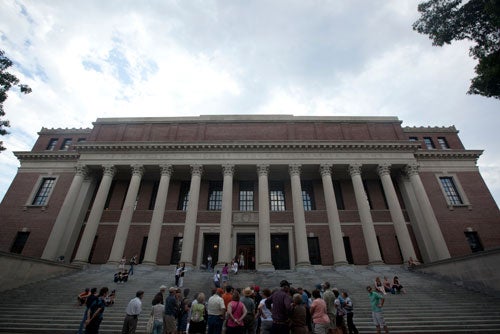
The new Harvard Library system will join individual libraries together into five affinity groups. “This affinity group model maintains the individuality of the libraries while providing mechanisms for the cross-campus collaboration that the system needs for its strategic development and overall organizational effectiveness,” said Provost Alan Garber.
Kris Snibbe/Harvard Staff Photographer
Library organization plan, timeline announced
Changes designed to build on system’s strategic capacity
The new Harvard Library system will join individual libraries together into five affinity groups based on similar collection needs, content areas, or specialized activities, according to Provost Alan Garber, who unveiled the new organizational plan today.
“The new Harvard Library structure, which emerged from deep analysis of the current system and consultations with the deans, faculty, and administrators across the libraries over the past year, is designed to clarify decision-making responsibilities throughout the system, deliver shared services as effectively as possible, and foster collaboration between libraries and with institutions beyond Harvard’s gates,” Garber said in a letter to the Harvard community.
“This affinity group model maintains the individuality of the libraries while providing mechanisms for the cross-campus collaboration that the system needs for its strategic development and overall organizational effectiveness,” Garber said.
The model also maintains the direct relationship between individual libraries and their Schools, while establishing a reporting responsibility to a group head who will be charged with advancing the strategic goals of the new Harvard Library, such as developing the collections.
Mary Lee Kennedy, the senior associate provost for the Harvard Library, said that while the plan was the product of a broad set of conversations across campus, the Library Board wanted to allow flexibility as the structure was implemented and has provided ways for individual libraries to shift between affinity groups as consultations continue with faculty members and the Schools and library heads over the next month.
“In the new Harvard Library structure, all libraries continue to report to their School as contributors to the pursuits of research, teaching, and learning,” said Kennedy. “Affinity group membership makes collaboration among libraries of different Schools even more effective.”
In his letter, the provost also explained that the design phase of the library transition is expected to conclude at the end of this calendar year, when Kennedy and other members of the Harvard Library leadership and the transition team will refocus their efforts on the implementation of the design.
Helen Shenton, executive director of Harvard Library, explained that the design included a plan for handling functions common to all the libraries through a shared services system, which will include information and technical services, access services, preservation, and digital imaging.
“This will provide an efficient way to implement decisions by the Library Board and president, while the affinity groups will continue to cultivate individual expertise of the libraries and facilitate even closer ties with the faculty and their work,” Shenton said.




